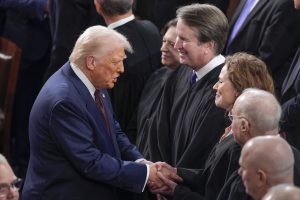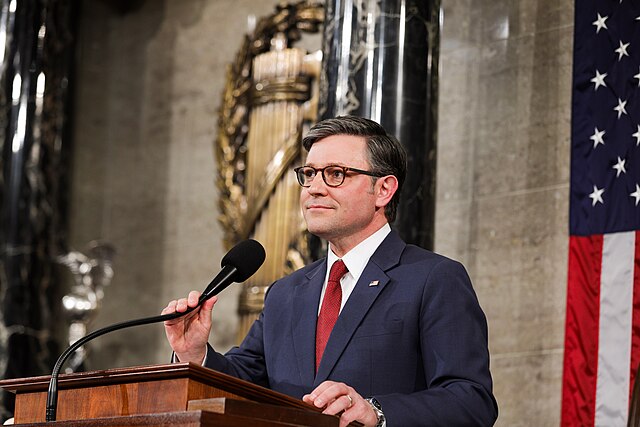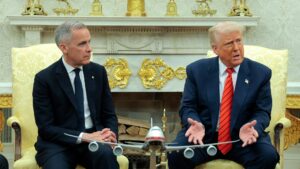A heated on-air exchange between Speaker of the House Mike Johnson and ABC News host George Stephanopoulos underscored the growing partisan divide over the recent government shutdown, reflecting deeper ideological tensions about fiscal policy, healthcare coverage, and immigration priorities. The televised confrontation, which occurred Wednesday morning, offered an unfiltered look into how both major parties are framing responsibility for the lapse in federal funding that began at midnight.
The discussion revolved around a central question: whether Democratic leaders’ proposal to extend healthcare access amounted to a protection for vulnerable Americans or a partisan maneuver that derailed efforts to keep the government open. Johnson, representing House Republicans, accused Senate Democrats of rejecting a “clean, nonpartisan continuing resolution” and instead prioritizing policy changes that would extend benefits to noncitizens. Stephanopoulos challenged that characterization, asserting that the proposal was designed to protect millions of Americans from losing health insurance or facing higher premiums.
The sharp exchange illuminated a fundamental disagreement not only over the causes of the shutdown but also over the language used to describe it. In an increasingly polarized media environment, moments like these reveal how narratives are crafted in real time—often shaping public understanding before policy outcomes are even finalized.
The Policy Divide: Clean Resolution vs. Conditional Funding
At the heart of the dispute is the concept of a “clean” continuing resolution (CR)—a temporary funding measure that maintains current government spending levels without policy riders or new conditions. Johnson and House Republicans argue that their proposal met that definition, preserving government operations while avoiding partisan conflicts. According to the Speaker, Senate Democrats “voted to reject a clean nonpartisan resolution to keep the government open,” opting instead for provisions that, in his words, “give healthcare to illegal aliens instead of maintaining critical services for American citizens.”
Democrats dispute that framing. Senate leaders, including Majority Leader Chuck Schumer, have maintained that their proposal was aimed at ensuring Americans do not lose health coverage during the shutdown period and that public health programs remain funded. The inclusion of certain healthcare-related provisions, they contend, was a necessary step to protect coverage continuity for both citizens and legal residents.
The procedural disagreement might appear technical, but its implications are broad. A continuing resolution is often a temporary fix to prevent government shutdowns while negotiations continue on full-year appropriations bills. However, when either side adds policy conditions—on immigration, healthcare, or other issues—what should be a routine process becomes a political battleground.
Competing Framing and Media Optics
The televised clash between Johnson and Stephanopoulos became emblematic of how political communication now operates within distinct partisan spheres. Stephanopoulos’s question framed the Democratic proposal as one aimed at preventing hardship: “The Democratic proposal is designed to prevent millions of Americans from losing their health insurance, losing Medicaid coverage, or paying higher premiums. Why are you against that?”
Johnson responded forcefully, calling the statement “absurd” and insisting that Democrats were misrepresenting the facts. “Let’s be clear about what happened last night, George,” he said, before outlining his version of events. “Forty-four Senate Democrats voted to reject a clean nonpartisan resolution to keep the government open. They chose instead to attach healthcare benefits for illegal immigrants, rather than maintain services for American citizens.”
Stephanopoulos countered by labeling his earlier comment a “factual statement,” emphasizing that Democrats viewed their measure as protecting Americans from negative coverage impacts. Johnson’s rebuttal centered on the procedural purity of the GOP’s proposal and the consistency of past Democratic support for similar measures earlier in the year. “It’s exactly what Chuck Schumer and other Democrats voted for in March, but they changed their tune,” Johnson said. “They’re trying to outrun the far-left portion of their base, so they’ve decided to inflict pain on the American people.”
This exchange—contentious but controlled—illustrated the current state of televised political discourse: policy disputes reframed as moral or factual ones, each side asserting ownership over “truth.”
Shutdown Fallout and Political Implications
As the government shutdown took effect, the immediate consequences rippled across federal agencies, from delayed paychecks for public employees to disruptions in administrative services. Both parties blamed the other for the impasse. Republicans insisted that Democrats were holding essential funding hostage to pursue ideological goals, while Democrats accused Republicans of obstructing necessary measures to protect healthcare access.
Behind the public sparring lies a deeper strategic calculus. For Republicans, emphasizing a “clean” funding approach reinforces their narrative of fiscal discipline and prioritizing citizens over noncitizens. For Democrats, linking the funding bill to healthcare protections underscores their broader message of compassion and public welfare. Each side seeks to position itself as the defender of the average American, while casting the other as out of touch or politically cynical.
The standoff also exposes the growing difficulty of bipartisan cooperation on even temporary funding agreements—a function that once passed with minimal controversy. In today’s political climate, every budgetary negotiation becomes a proxy for larger ideological wars over immigration, healthcare, and social spending.
Political Context and Leadership Dynamics
Speaker Johnson’s position in these negotiations carries particular significance. Having taken office amid intra-party divisions earlier this year, Johnson has sought to project unity within the Republican conference while maintaining a disciplined fiscal message. His emphasis on a “nonpartisan” resolution signals an attempt to frame the GOP as pragmatic stewards of governance rather than obstructionists.
However, Democrats see the situation differently. Many Senate Democrats argue that the so-called “clean” resolution lacked critical provisions that would safeguard coverage for vulnerable populations, particularly as Medicaid redeterminations proceed following the end of pandemic-era protections. They contend that excluding these measures would effectively lead to coverage losses, a policy outcome they view as unacceptable.
Meanwhile, Senate Majority Leader Schumer has faced internal pressure from progressive members to use the funding negotiations as leverage to advance policy priorities, while moderates within the caucus worry about the political costs of a prolonged shutdown. The balancing act reflects the same internal divisions Johnson attributes to the opposing party.
The Broader Narrative: Accountability and Messaging
Beyond the legislative specifics, the exchange between Johnson and Stephanopoulos also speaks to the evolving relationship between political leaders and the media. In recent years, figures on both sides have increasingly treated interviews as arenas for direct message delivery to their respective bases. Johnson’s firm pushback against Stephanopoulos’s framing was as much a performance of leadership as a policy defense, aimed at demonstrating confidence and clarity amid partisan turbulence.
For Stephanopoulos, the interaction reaffirmed the media’s role in pressing public officials to clarify and defend their claims—especially when factual disputes hinge on competing interpretations rather than verifiable data. His insistence that the Democratic proposal’s intentions were “factual” reflects journalism’s ongoing struggle to navigate between objective reporting and interpretive framing in a polarized environment.
A Reflection of Broader Political Realities
Ultimately, the exchange symbolized more than a disagreement over one funding bill. It highlighted how deeply entrenched political identities have become in defining the meaning of fairness, responsibility, and governance. Even procedural issues—like how to pass a short-term spending measure—are now filtered through partisan narratives about morality, national identity, and loyalty to the public good.
As the shutdown continues, the substantive consequences will likely become clearer: delays in federal operations, uncertainty for employees, and possible economic ripple effects. Yet, for many Americans watching the interview, what may stand out most is the tone—the palpable frustration of two public figures reflecting the national mood.
In an era when political debates are increasingly waged through televised soundbites and viral clips, moments like this one serve both as a mirror and a warning. They show a political system struggling not only to govern but to communicate across its own ideological divides.
Until a resolution is reached, both parties will continue refining their narratives—each claiming to represent the public’s true interests, even as Americans watch the practical costs of stalemate unfold.

Emily Johnson is a critically acclaimed essayist and novelist known for her thought-provoking works centered on feminism, women’s rights, and modern relationships. Born and raised in Portland, Oregon, Emily grew up with a deep love of books, often spending her afternoons at her local library. She went on to study literature and gender studies at UCLA, where she became deeply involved in activism and began publishing essays in campus journals. Her debut essay collection, Voices Unbound, struck a chord with readers nationwide for its fearless exploration of gender dynamics, identity, and the challenges faced by women in contemporary society. Emily later transitioned into fiction, writing novels that balance compelling storytelling with social commentary. Her protagonists are often strong, multidimensional women navigating love, ambition, and the struggles of everyday life, making her a favorite among readers who crave authentic, relatable narratives. Critics praise her ability to merge personal intimacy with universal themes. Off the page, Emily is an advocate for women in publishing, leading workshops that encourage young female writers to embrace their voices. She lives in Seattle with her partner and two rescue cats, where she continues to write, teach, and inspire a new generation of storytellers.









